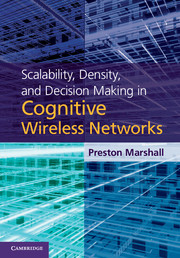Book contents
- Frontmatter
- Contents
- Preface
- Part I Overview
- 1 Introduction
- 2 Theoretical foundations
- 3 Future wireless operation, environments, and dynamic spectrum access
- 4 Some fundamental challenges in cognitive radio and wireless network systems
- Part II Generalized environmental characterization
- Part III System performance of cognitive wireless systems
- Part IV Integrated awareness and decision making
- Part V Summary
- Part VI Appendices
- Index
- References
4 - Some fundamental challenges in cognitive radio and wireless network systems
from Part I - Overview
Published online by Cambridge University Press: 05 December 2012
- Frontmatter
- Contents
- Preface
- Part I Overview
- 1 Introduction
- 2 Theoretical foundations
- 3 Future wireless operation, environments, and dynamic spectrum access
- 4 Some fundamental challenges in cognitive radio and wireless network systems
- Part II Generalized environmental characterization
- Part III System performance of cognitive wireless systems
- Part IV Integrated awareness and decision making
- Part V Summary
- Part VI Appendices
- Index
- References
Summary
Introduction to wireless system challenges
In this chapter, we will explore some of the fundamental challenges that are common to most, if not all, wireless networking systems and architectures. The intent is to approach the problem in a general framework that can derive meaningful insights into the broad categories of wireless architectures, as well as specific issues associated with specific architectures and designs. Although many of the current wireless architectures are highly specialized and homogeneous, it will be shown that the necessity for increased capability and cost-effective performance, within increasing spectrum constraints, is driving architectures to become more expansive and heterogeneous in their structure. These structures introduce opportunities for optimization across a range of heterogeneous techniques, technologies, and architectures, as well as a requirement for unique optimization methods within each of the homogeneous architectures. This chapter will also introduce some of the fundamental metrics that will be the basis for subsequent analysis and for the development of decision criteria.
Evolution of wireless and mobile architectures
Although cellular and mobile communications are a special case of a wide number of wireless architectures, their impact on popular usage, and society in general, is profound. It is important that their specific trends, and design considerations, be reflected in even the most general treatment of wireless networking.
Not only is spectrum a highly constrained resource, but also energy consumption, real-estate for towers, visual obstruction, and other aspects of the wireless ecosystem are significant considerations in the evolution of wireless technology.
Information
- Type
- Chapter
- Information
- Publisher: Cambridge University PressPrint publication year: 2012
